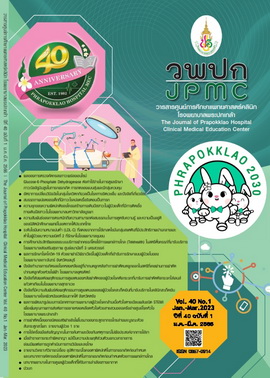Factors Predicting Residual Disease in Women with a Subsequent Hysterectomy Following the Loop Electrosurgical Excision Procedure for Cervical Intraepithelial Neoplasia at Uttaradit Hospital
Main Article Content
Abstract
BACKGROUND: Women who had residual disease left on their cervix after an initial cervical loop electrosurgical excision procedure carried a risk of recurrence or invasive cervical carcinoma progression. The study of the factors predicting the risk of residual lesions was therefore important for treatment.
OBJECTIVES: The study aimed to find the incidence and factors predicting residual disease in women with a subsequent hysterectomy following a loop electrosurgical excision procedure (LEEP) for cervical intraepithelial neoplasia at Uttaradit Hospital, Uttaradit Province, Thailand.
METHODS: This retrospective cohort study was under-taken by women with histology in a subsequent hysterectomy following the LEEP for cervical Intraepithelial neoplasia at Uttaradit Hospital during January 2014-March 2021. The research criteria were women who still had cervical intraepithelial neoplasia on the cervix within six weeks-12 months after treatment and had indications for a hysterectomy, including positive surgical margins following the LEEP that could not be a resection, or no cervical intraepithelial neoplasia but had indications of gynecological disease. The comparison group was those who had no lesions. The data were analyzed using descriptive statistics, Mantel-Jaenzel Chi-square test, and binary logistic regression.
RESULTS: One hundred and fifty-six women were included; residual disease was found in 56 women (35.9%). The factors predicting residual disease in a subsequent hysterectomy following the LEEP, included having endocervical margin involvement, aged ≥45 years, and had stromal invasion; with 94.2% of correct prediction.
CONCLUSIONS: Residual disease was found in 35.9% of the subsequent hysterectomy following the LEEP for cervical intraepithelial neoplasia, and the factors predicting the residual disease were at an acceptable level of accuracy in this study, which could be beneficial for appropriate management decision-making.
Article Details

This work is licensed under a Creative Commons Attribution-NonCommercial-NoDerivatives 4.0 International License.
References
International Agency for Research on Cancer. Latest world cancer statistics–globocan 2012: estimated cancer incidence, mortality and prevalence worldwide in 2012 [Internet] 2013 [cited 2021 Aug 31]. Available from: https://www.iarc.who.int/news events/latest-world-cancer-statistics-globocan-2012-estimated-cancer-incidence-mortality-and-prevalence-worldwide-in-2012/
Campion MJ. Preinvasive disease. In: Berek JS, Hacker F, editors. Berek and Hacker's gynecologic oncology. 5th ed. Philadelphia: Lippincott Williams & Wilkins; 2010. p.268-340.
Moore BC, Higgins RV, Laurent SL, Marroum MC, Bellitt P. Predictive factors from cold knife conization for residual cervical intraepithelial neoplasia in subsequent hysterectomy. Am J Obstet Gynecol 1995;173:361-6.
Jing L, Dan W, Zhunan L, Ying X, Yi C. Residual lesions in uterine specimens after loop electrosurgical excision procedure in patients with CIN. Arch Gynecol Obstet 2018;298:805-12.
Chen JY, Wang ZL, Wang ZY, Yang XS. The risk factors of residual lesions and recurrence of the high-grade cervical intraepithelial lesions (HSIL) patients with positive-margin after conization. Medicine (Baltimore) [Internet]. 2018[cited 2021 Aug 31];97(41):e12792. Available from: https://www.ncbi.nlm.nih.gov/pmc/articles/PMC6203583/pdf/medi-97-e12792.pdf
Abdulaziz AMA, You X, Liu L, Sun Y, Zhang J, Sun S, et al. Management of high-grade squamous intraepithelial lesion patients with positive margin after LEEP conization: a retrospective study. Medicine (Baltimore) [Internet]. 2021[cited 2021 Aug 31];100(20): e26030. Available from: https://www.ncbi.nlm.nih.gov/pmc/articles/PMC8137043/pdf/medi-100-e26030.pdf
Arbyn M, Redman CWE, Verdoodt F, Kyrgiou M, Tzafetas M, Ghaem-Maghami S, et al. Incomplete excision of cervical precancer as a predictor of treatment failure: a systematic review and meta-analysis. Lancet Oncol 2017;18:1665-79.
Fu Y, Chen C, Feng S, Cheng X, Wang X, Xie X, et al. Residual disease and risk factors in patients with high-grade cervical intraepithelial neoplasia and positive margins after initial conization. TherClin Risk Manag 2015; 11: 851-6.
Ayhan A, Tuncer HA, Reyhan NH, Kuscu E, Dursun P. Risk factors for residual disease after cervical conization in patients with cervical intraepithelial neoplasia grades 2 and 3 and positive surgical margins. Eur J Obstet Gynecol Reprod Biol 2016; 201: 1-6.
Swift BE, Wang L, Jembere N, Kupets R. Risk of recurrence after treatment for cervical intraepithelial neoplasia 3 and adenocarcinoma in situ of the cervix: recurrence of CIN 3 and AIS of cervix. J Low Genit Tract Dis 2020;24:252-8.
Kingnate C. Incidence and predictors of residual disease in women with high-grade squamous intraepithelial lesion (HSIL) and positive margins after cervical loop electrosurgical excision. Srinagarind Med J 2020;35:515-22.
Chikazawa K, Netsu S, Motomatsu S, Konno R. Predictors of recurrent/residual disease after loop electrosurgical excisional procedure. J Obstet Gynaecol Res 2016;42:457-63.
Feng H, Chen H, Huang D, He S, Xue Z, Pan Z, et al. Relationship between positive margin and residual/recurrence after excision of cervical intraepithelial neoplasia: a systematic review and meta-analysis. Transl Cancer Res 2022;11:1762-9.
Sun X,Lei H, Xie X, Ruan G, An J, Sun P. Risk factors for residual disease in hysterectomy specimens after conization in post menopausal patients with cervical intraepithelial neoplasia grade 3. Int J Gen Med 2020;13:1067-74.
Ge Y, Liu Y, Cheng Y, Liu Y. Predictors of recurrence in patients with high-grade cervical intraepithelial neoplasia after cervical conization. Medicine (Baltimore) [Internet]. 2021 [cited 2021 Aug 31];100(27):e26359. Available from: https://www.ncbi.nlm.nih.gov/pmc/articles/PMC8270570/pdf/medi-100-e26359.pdf
Natee J, Therasakvichaya S, Boriboonhirunsarn D. Prevalence and risk factors for residual cervical neoplasia in subsequent hysterectomy following LEEP or conization. J Med Assoc Thai 2005;88:1344-8.
Lin H, Chang HY, Huang CC, Changchien CC. Prediction of disease persistence after conization for microinvasive cervical carcinoma and cervical intraepithelial neoplasia grade 3. Int J Gynecol Cancer 2004;14:311-6.
JenrungrojsakulN. Factors associated with cervical cone margin after loop electrosurgical excision procedure (LEEP) in women with cervical intraepithelial neoplasia at Uttaradit hospital. Journal of Health Science, Thaksin University 2020;2(1):9-20.
Sezgin B. Outcomes of two years follow-up after loop electrosurgical excision procedure in a universityhospital. Ulutas Med J 2020;6:156-61.
Ryu A, Nam K, Kwak J, Kim J, Jeon S. Early human papillomavirus testing predicts residual/recurrent disease after LEEP. J Gynecol Oncol 2012;23:217-25.
Bruno MT, Cassaro N, Garofalo S, Boemi S. HPV16 persistent infection and recurrent disease after LEEP. Virol J 2019;16:148.

